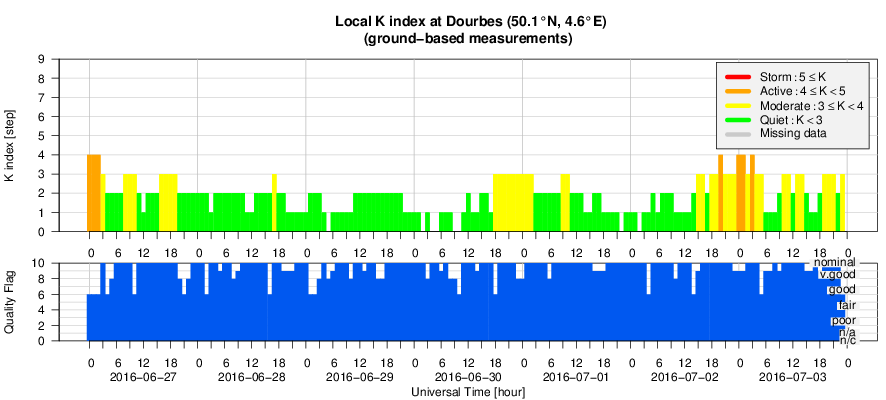- Table of Content
- 1.Backside erupt...
- 2.Review of sola...
- 3.The Internatio...
- 4.PROBA2 Observa...
- 5.Review of geom...
- 6.Geomagnetic Ob...
- 7.Review of iono...
- 8.Future Events
- 9.New documents ...
2. Review of solar activity
3. The International Sunspot Number
4. PROBA2 Observations (27 Jun 2016 - 3 Jul 2016)
5. Review of geomagnetic activity
6. Geomagnetic Observations at Dourbes (27 Jun 2016 - 3 Jul 2016)
7. Review of ionospheric activity (27 Jun 2016 - 3 Jul 2016)
8. Future Events
9. New documents in the European Space Weather Portal Repository
Backside eruptions
Once again, solar observers were treated on a blemishless golden orb, with the preliminary sunspot number being "0" from 25 June onwards. While the earth-facing solar hemisphere had apparently already left for the summer holidays, the Sun's backside still showed some signs of life, displaying a few active regions. Extreme ultraviolet imagery underneath shows the difference between the earth-facing side and the Sun's farside as seen by respectively SDO (left; AIA 193) and STEREO-A (right; EUVI 195) on 1 July. The dark patches represent coronal holes, the bright patches correspond to active regions (not necessarily sunspot groups).
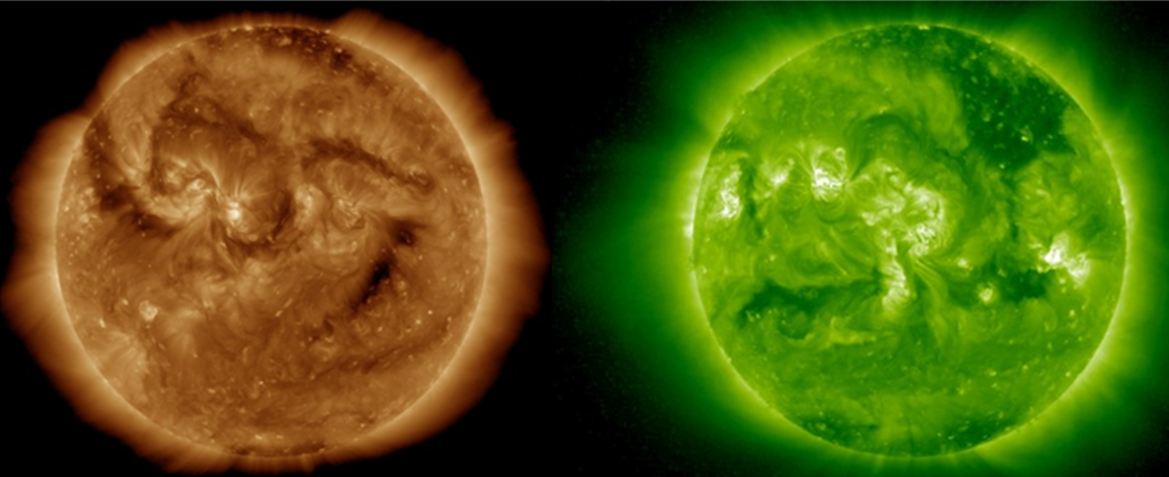
Interestingly, there was quite some flaring activity in these regions on 30 June. Strong flaring was observed in an active region located in the northeast solar quadrant as seen by STEREO-A during the 01-05UT interval. Then, during the afternoon of the same day, flaring activity picked up in the regions more to the disk's center culminating in a major eruption around 17:00UT. The two periods of flaring activity are indicated in the STEREO-A imagery underneath (http://stereo-ssc.nascom.nasa.gov/beacon/beacon_secchi.shtml ).
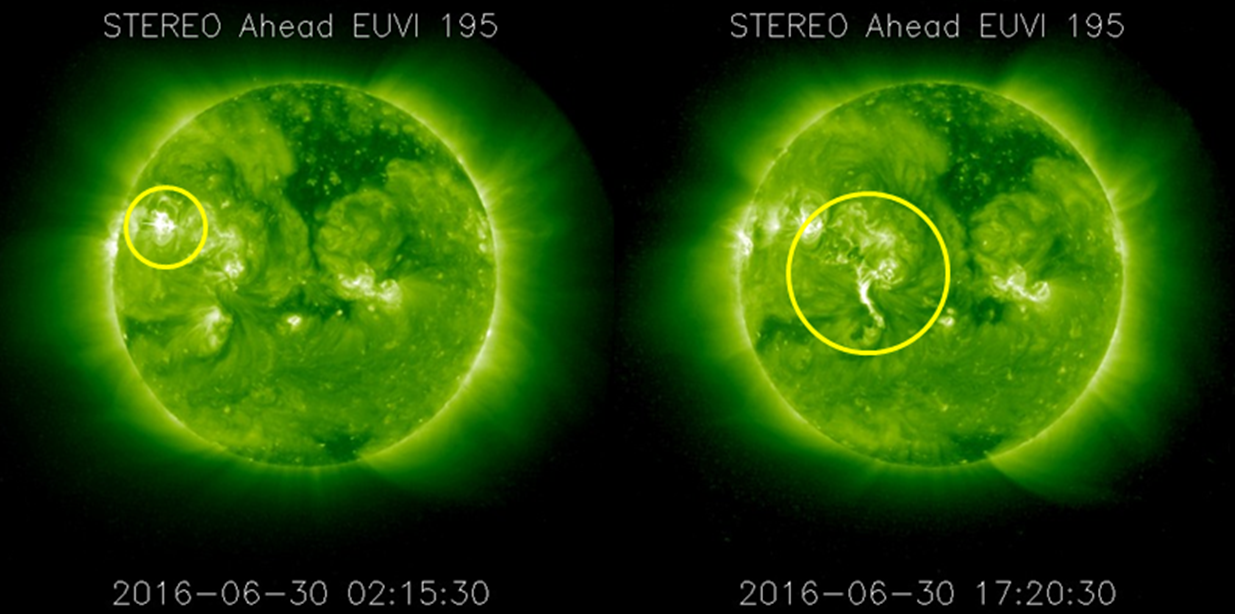
Both flaring episodes were associated with coronal mass ejections (CME). The CME related to the major eruption had a plane-of-the-sky speed between 350 and 500 km/s, and had a STEREO-A directed component. The spacecraft recorded a shock in the solar wind speed (jump from 470 to 620 km/s) and in the strength of the magnetic field B (about 19 nT) around 20UT on 2 July.
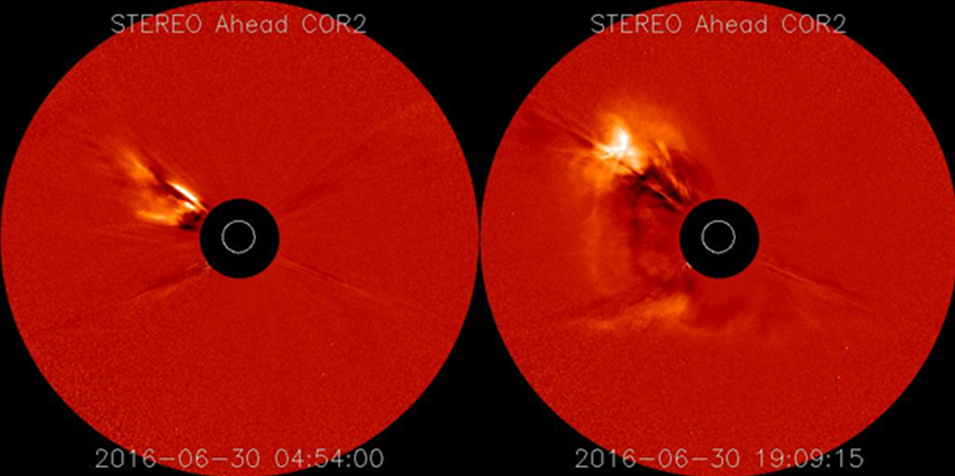
A movie based on STEREO imagery can be found at https://youtu.be/mg8qp5dgDwM The concerned active regions are expected to round the east solar limb -as seen from Earth- by 6 or 7 July. Hopefully, they'll still have some juice left by then...
Review of solar activity
Solar activity was very low during the whole week. Only five low-level B-class flares were recorded, and no earth-directed coronal mass ejections (CME) were observed. The only wide CME was first seen in the SOHO/LASCO C2 field of view at about 17:00UT on 30 June. The full halo CME was a backside event, and therefore not earth-directed.
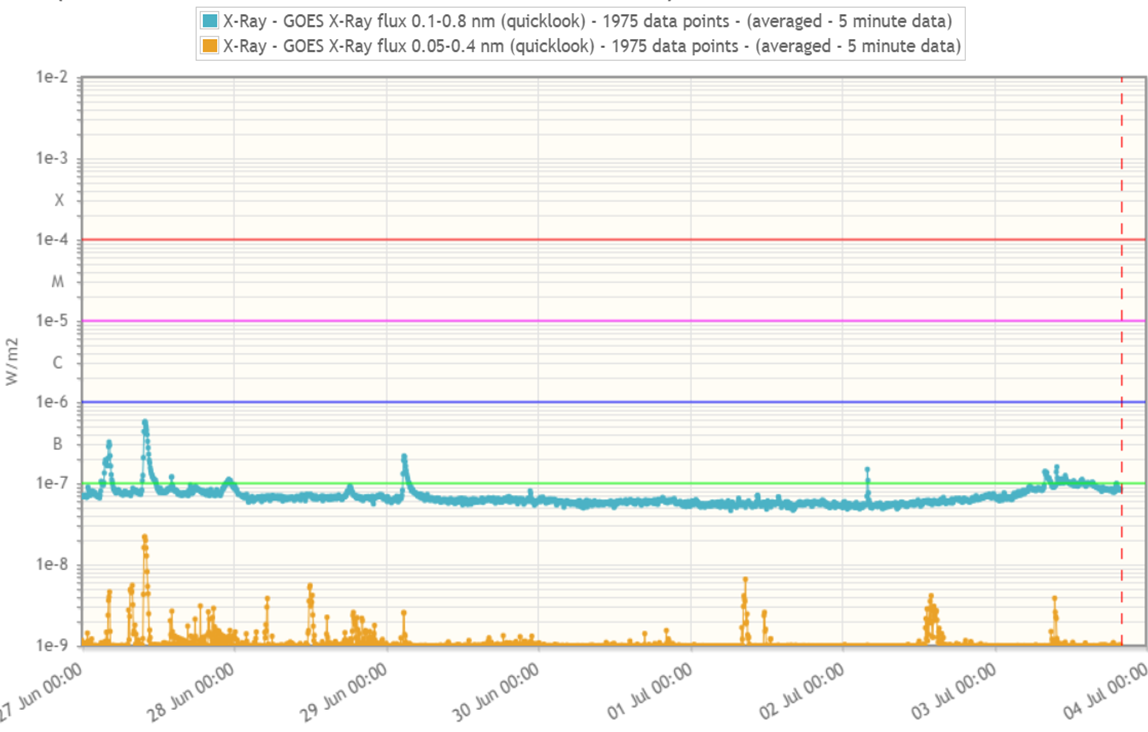
The Sun has been spotless since 25 June. NOAA 2556 was the last sunspot group visible on the solar disk. It can be seen as a tiny speck in the SDO/HMI image underneath taken early on 24 June.
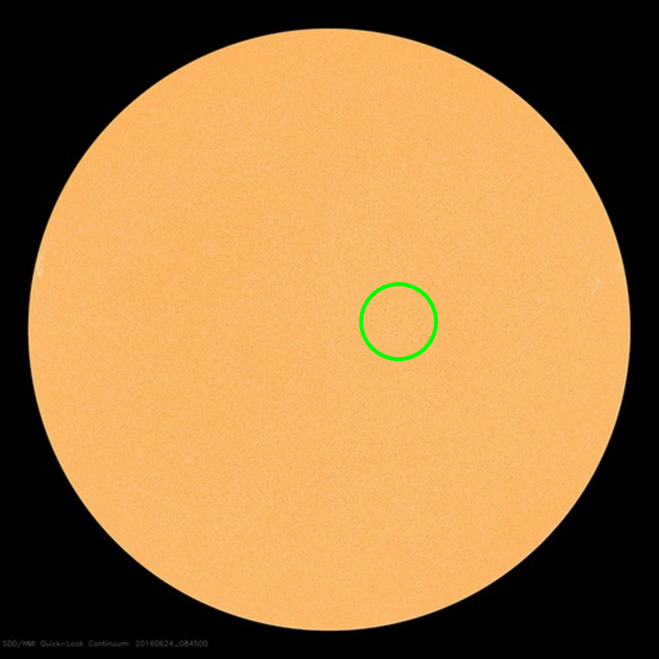
The International Sunspot Number
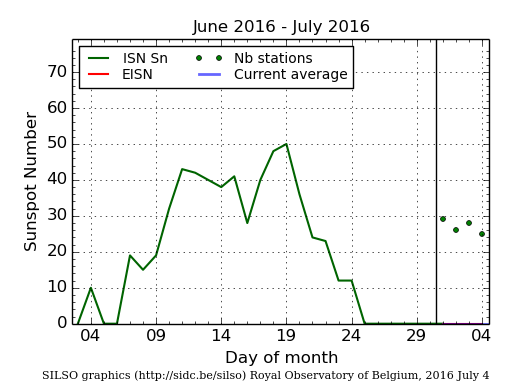
The daily Estimated International Sunspot Number (EISN, red curve with shaded error) derived by a simplified method from real-time data from the worldwide SILSO network. It extends the official Sunspot Number from the full processing of the preceding month (green line). The plot shows the last 30 days (about one solar rotation). The horizontal blue line shows the current monthly average, while the green dots give the number of stations included in the calculation of the EISN for each day.
PROBA2 Observations (27 Jun 2016 - 3 Jul 2016)
Solar Activity
Solar flare activity fluctuated remained very low during the week.
In order to view the activity of this week in more detail, we suggest to go to the following website from which all the daily (normal and difference) movies can be accessed:
http://proba2.oma.be/ssa
This page also lists the recorded flaring events.
A weekly overview movie can be found here (SWAP week 327).
http://proba2.oma.be/swap/data/mpg/movies/weekly_movies/weekly_movie_2016_06_27.mp4
Details about some of this week's events, can be found further below.
Monday Jun 27
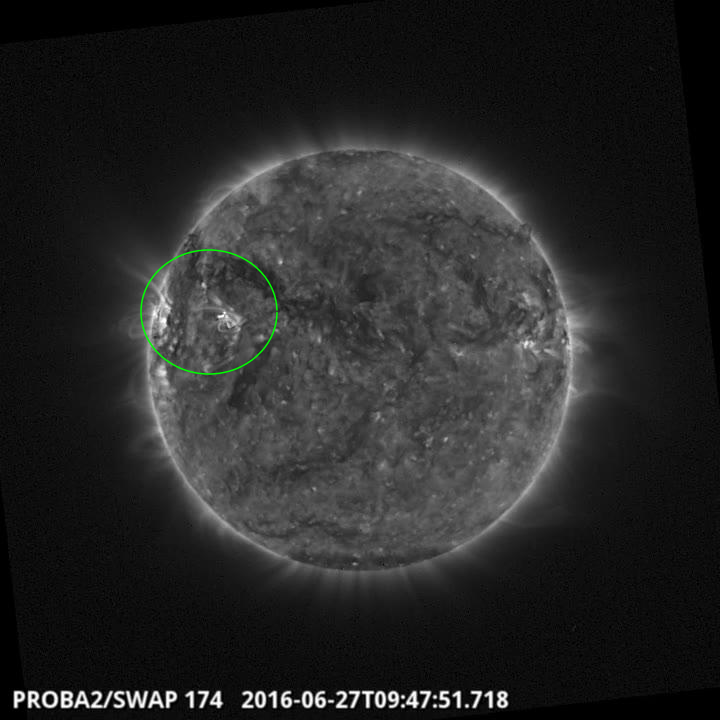
An eruption was observed by SWAP on the north east quadrant of the Sun on 2016Jun27 at
09:47 UT
Find a movie of the events here (SWAP movie)
http://proba2.oma.be/swap/data/mpg/movies/20160627_swap_movie.mp4
Sunday Jul 03
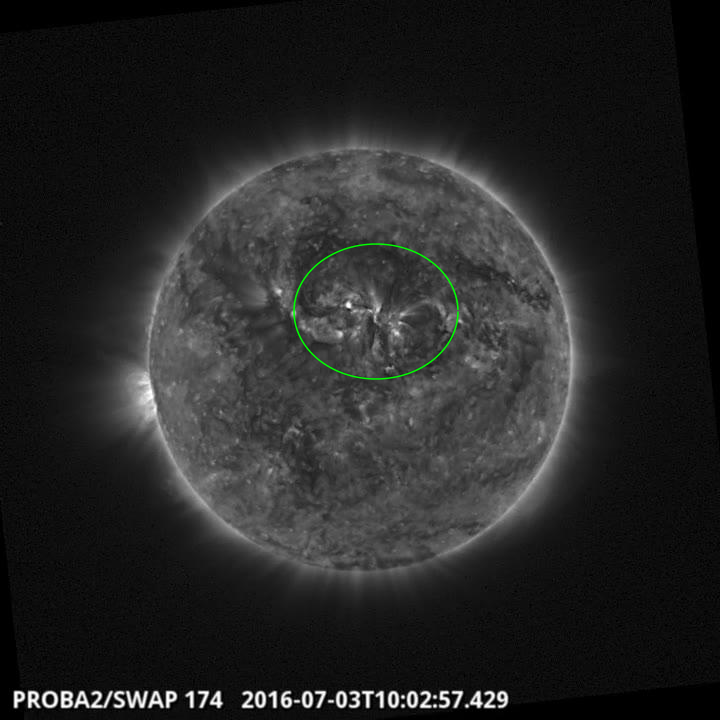
An eruption was observed by SWAP on the centre of the Sun on 2016Jul03 at 10:02 UT
Find a movie of the events here (SWAP movie)
http://proba2.oma.be/swap/data/mpg/movies/20160703_swap_movie.mp4
Review of geomagnetic activity
The geomagnetic conditions during the week were mostly quiet with only isolated intervals of unsettled to active geomagnetic conditions.
At the beginning of the period, the earth environment was still under the (waning) influence of a high speed stream from a coronal hole. For the rest of the week, the solar wind at Earth was dictated by the solar wind stream from 2 coronal holes (CH). Both CHs were rather small and located close to the solar equator. CH1 (indicated by the yellow arrow) had a positive ("away" from the Sun) orientation of the magnetic field and transited the Sun's central meridian (CM) on 26 June. CH2 (indicated by the red arrow) had a negative ("towards") magnetic field orientation and transited the CM on 28 June.
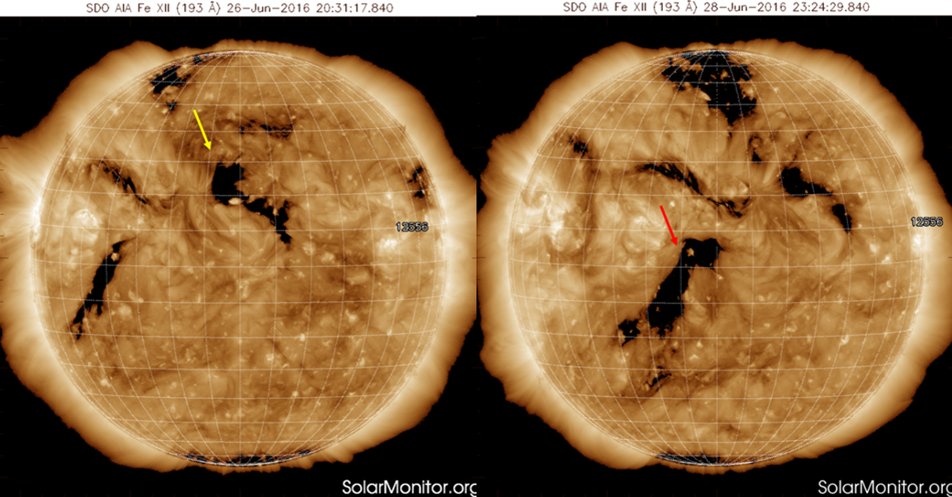
Solar wind speed (yellow curve) declined from an initial 500 km/s to about 340 km/s by noon on 30 June. It then gradually increased to values near 410 km/s under the influence of the wind stream from CH1 by early July. The interplanetary magnetic field (IMF; blue curve) turned from "towards" to "away" from the Sun. The IMF turned back to "towards" upon the arrival of the moderate speed stream from CH2 late on 2 July, when speeds near 490 km/s were recorded. The magnetic field strength B (white curve), density (orange curve) and temperature (green curve) were a bit more pronounced with this stream than the one from CH1. Hence, active geomagnetic conditions were recorded by both Dourbes and NOAA (Kp) late on 2 July. The rest of the week featured only quiet to unsettled geomagnetic conditions.
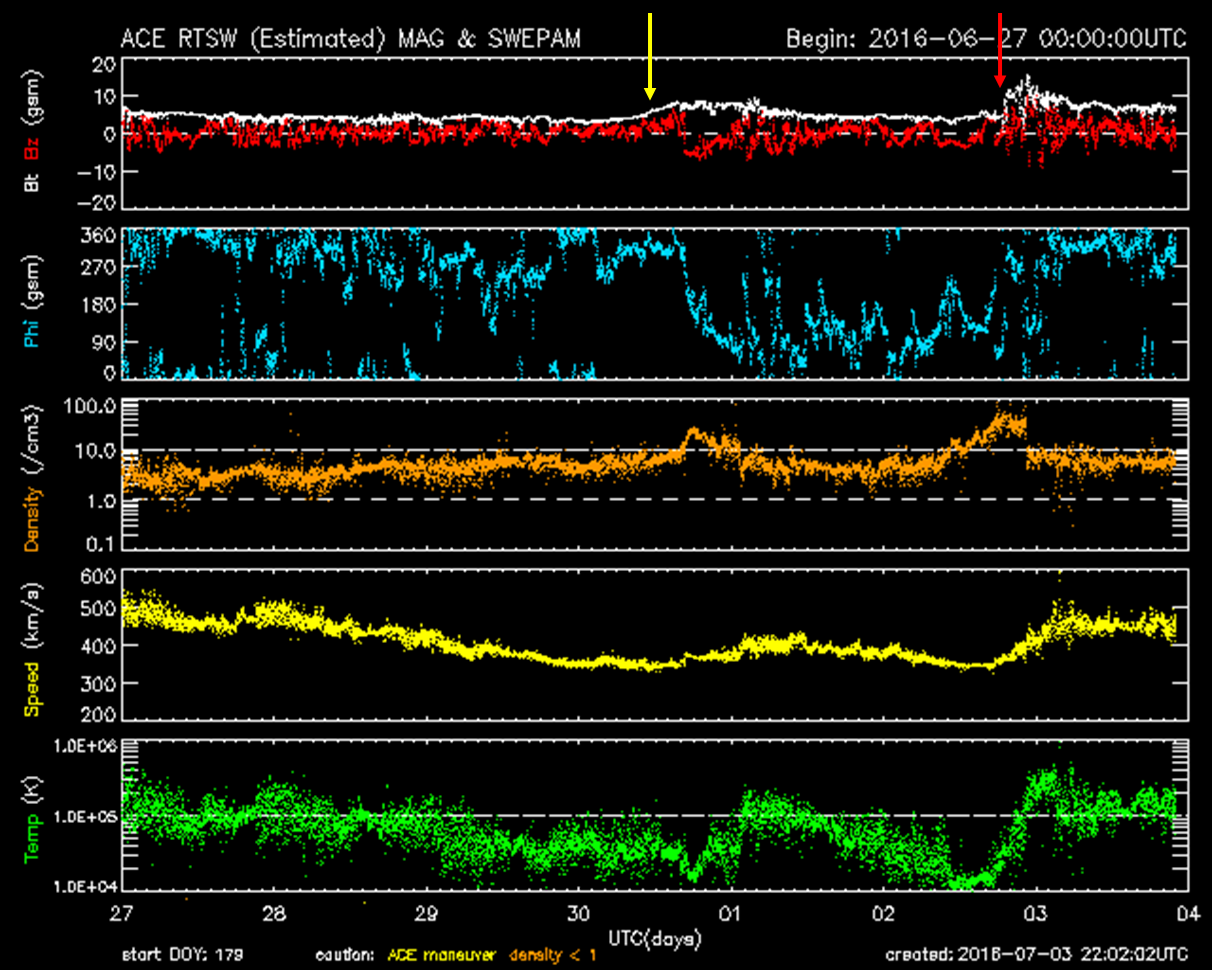
Review of ionospheric activity (27 Jun 2016 - 3 Jul 2016)
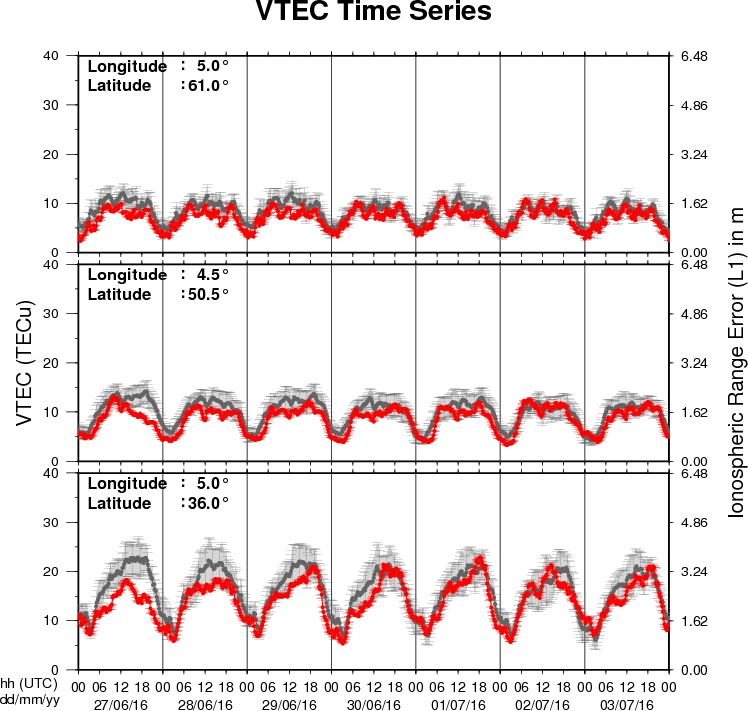
The figure shows the time evolution of the Vertical Total Electron Content (VTEC) (in red) during the last week at three locations:
a) in the northern part of Europe(N61°, 5°E)
b) above Brussels(N50.5°, 4.5°E)
c) in the southern part of Europe(N36°, 5°E)
This figure also shows (in grey) the normal ionospheric behaviour expected based on the median VTEC from the 15 previous days.
The VTEC is expressed in TECu (with TECu=10^16 electrons per square meter) and is directly related to the signal propagation delay due to the ionosphere (in figure: delay on GPS L1 frequency).
The Sun's radiation ionizes the Earth's upper atmosphere, the ionosphere, located from about 60km to 1000km above the Earth's surface.The ionization process in the ionosphere produces ions and free electrons. These electrons perturb the propagation of the GNSS (Global Navigation Satellite System) signals by inducing a so-called ionospheric delay.
See http://stce.be/newsletter/GNSS_final.pdf for some more explanations ; for detailed information, see http://gnss.be/ionosphere_tutorial.php
Future Events
For more details, see http://www.spaceweather.eu/en/event/future
Global Modelling of the Space Weather Chain in Helsinki, Finland
Start : 2016-10-24 - End : 2016-10-28
This event brings together solar, heliospheric, magnetospheric,
and ionospheric communities to discuss the current state and future
challenges in global modelling of the entire space weather chain.
Major developments in forecasting space weather, and understanding
the effects of solar eruptions requires increased communication and
collaboration of these often rather distinct communities. We
welcome submissions from these modelling communities and also
synergetic studies utilising both observations and numerical
models.
Website:
https://pnst.ias.u-psud.fr/sites/pnst/files/global_modelling_space_weather_oct2016.pdf
European Space Weather Week in Ostend, Belgium
Start : 2016-11-14 - End : 2016-11-18
The ESWW is the main annual event in the European Space Weather
calendar. It is the European forum for Space Weather as proven by
the high attendance to the past editions. The agenda will be
composed of plenary/parallel sessions, working meetings and
dedicated events for service end-users. The ESWW will again adopt
the central aim of bringing together the diverse groups in Europe
working on different aspects of Space Weather.
Website:
http://www.stce.be/esww13/
Solar Orbiter Workshop 7: Exploring the solar environs in Granada, Spain
Start : 2017-04-03 - End : 2017-04-06
This event will be hosted by the Instituto de Astrofisica de
Andalucia - CSIC. Please mind that on April 7th the 20th SWT
meeting will take place at the same venue.
Website: Unkown
